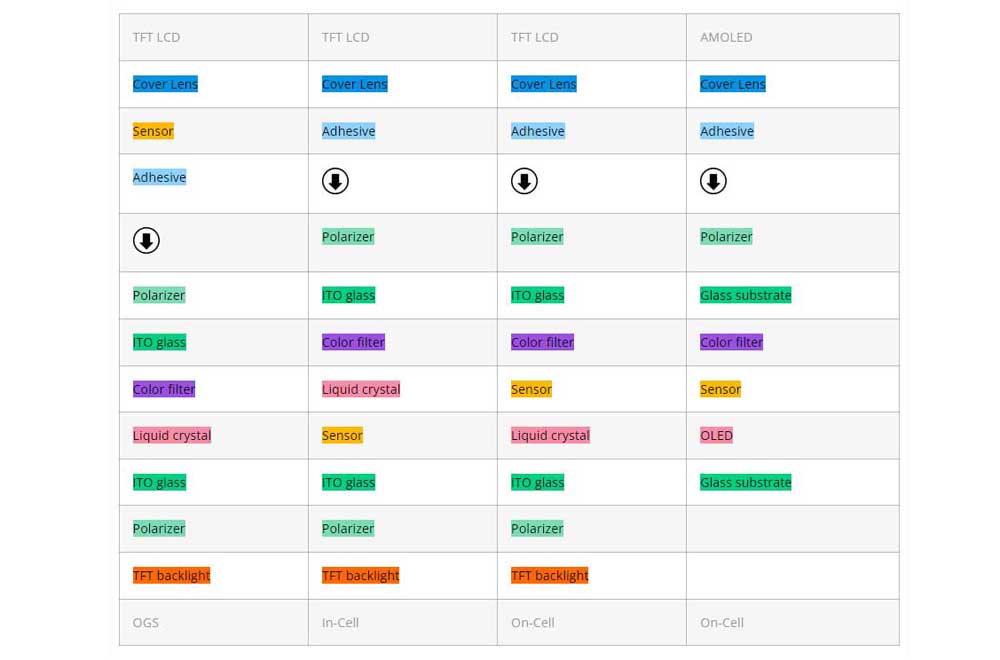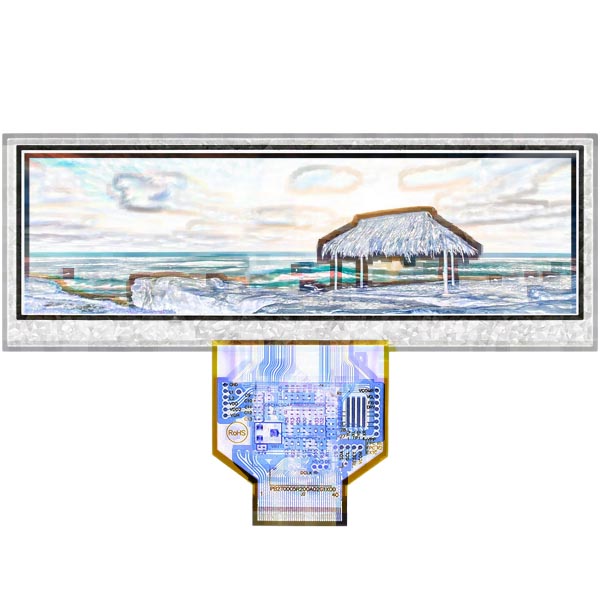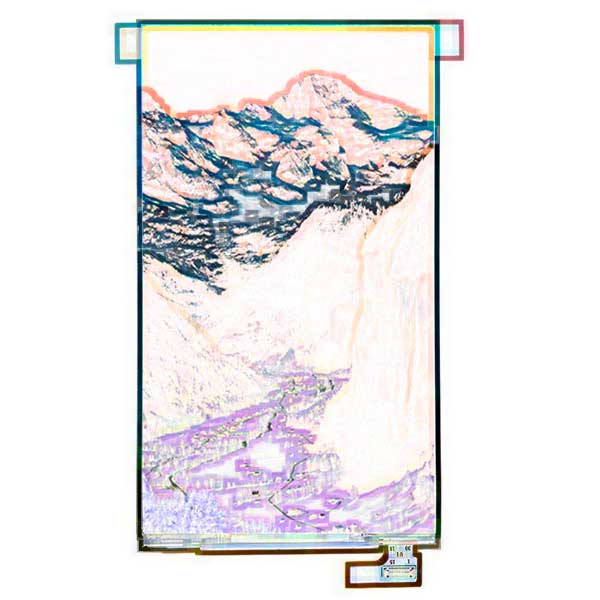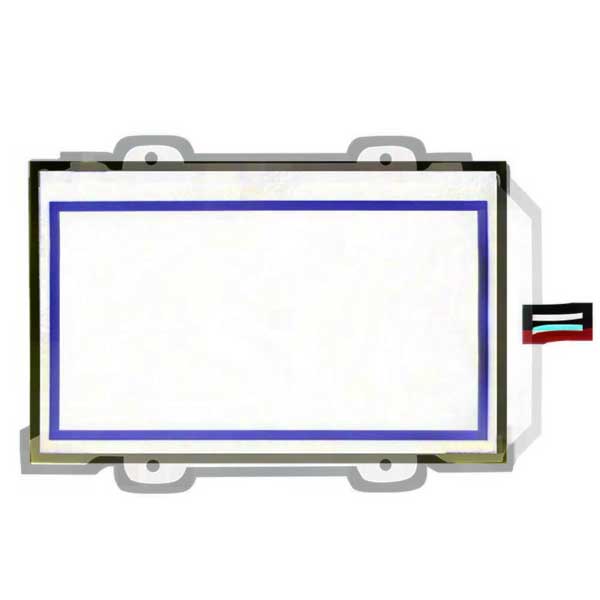In the production process of display screens, it is necessary to bond the protective glass, touch screen, and display screen twice. The display effect will be greatly reduced if air gap bonding is used. However, the pass rate will be problematic if optical bonding is used. The pass rate will be greatly reduced when the protective glass, touch screen, and display screen go through a bonding production procedure. If the times of bonding can be reduced, the pass rate of full bonding will undoubtedly be improved. At present, there are several development trends: OGS/TOL schemes dominated by the original touch screen manufacturers, and On Cell and In Cell technical schemes dominated by display panel manufacturers. More powerful display panel manufacturers tend to promote On-Cell or In-Cell solutions, mainly because they are capable of producing displays; that is, they tend to make the touch layer on display screens. Touch module manufacturers or upstream material manufacturers prefer OGS. That is, the touch sensor is integrated into the protective glass. The main reason is that they have strong ability and technology in the manufacturing process. The common ground of the two schemes is to reduce the bonding times so that the cost can be reduced and the bonding pass rate can be improved. In addition, since one touch layer has been omitted, the cost of materials is reduced, and the product becomes lighter and thinner. Among them, the screen of the iPhone series uses In-Cell technology.
1. In-Cell
In-Cell refers to embedding the touch panel function into the liquid crystal pixel, that is, embedding the touch sensor function inside the display screen, which can make the screen thinner and lighter. Meanwhile, the In-Cell screen should be embedded with a matching touch IC. Otherwise, it will easily lead to wrong touch sensing signals or excessive noise. Therefore, for any display panel manufacturer, the threshold for applying In-Cell/On-Cell touchscreen technology is indeed quite high, and they still need to overcome the difficulty of a low pass rate. The thickness of the iPhone5’s screen using In-Cell technology is estimated to be 2.54 mm. In-Cell contributes 0.44 mm in the thickness reduction, accounting for about 25% of the total thickness reduction (1.7 mm).
Although Apple, a giant in technology, is pushing In-Cell technology, the technology will still be limited to high-end smartphones in the next few years. The main problem is the pass rate. Because if the In-Cell is damaged, not only the touch screen will be scrapped, but also the display screen. Therefore, manufacturers require a higher pass rate of In-Cell.
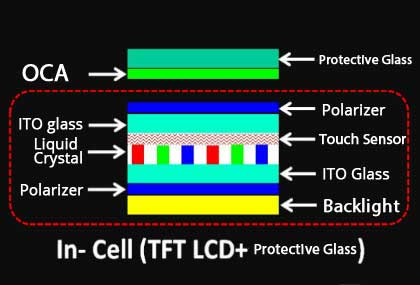
5 Advantages of In-Cell
1. The first benefit the iPhone can get from In-cell technology is that it becomes thinner. Although the In-cell screen can only reduce the thickness of the iPhone by less than 0.5 mm, analysts have said that precious metal materials instead of the fashionable glass may be used to make the shell of the iPhone, and the thickness can also be reduced by 1mm. It sounds like the thickness reduction is not much, but users can still feel the improvement when holding the phone.
2. Display quality improvement is also one of the benefits of the In-cell touchscreen panel. We all have this experience. When we tear off a screen protector, we suddenly feel that the display content is much clearer. That’s because the more layers the light has to penetrate, the worse the picture definition. As mentioned above, In-cell reduces the screen layers by one. In theory, the display quality of In-cell should be better than On-cell.
3. The thinner screen means that the weight will be reduced unless Apple adds other components. If Apple does increase the screen size, as rumored, the overall weight of the iPhone may stay the same.
4. The screen is thinner. Thus there will be more space for a battery in iPhone. Users have higher and higher requirements for the battery serving time of iPhone, and Apple is improving hardware while maintaining battery serving time. The solution is to use a larger battery. Therefore, for the space saved by the In-cell screen, if Apple does not consider making the iPhone thinner, the next step will be to consider making the iPhone battery larger and improving the battery serving time.
5. Finally, in-cell technology also makes the manufacturing process of Apple suppliers more efficient and has a lower failure rate. Although the in-cell screen is more challenging to produce, it can reduce the time for manufacturers to bond the layers of the screen. As long as suppliers break through technical difficulties, it is not a problem to speed up production efficiency. However, the production efficiency of traditional on-cell screens has reached a bottleneck, which is difficult to break through.
2. On-Cell
On-Cell refers to the touch screen embedded between the color filter substrate and the polarizer of the display screen. That is, the touch sensor is equipped on the liquid crystal panel. Compared with In-Cell, its technology difficulty is much lower. Samsung, Hitachi, LG, and other manufacturers have rapidly progressed in On-Cell touch screens. At present, On-Cell is mostly used in Samsung AMOLED panels, but the problems of thickness and uneven color during touching still need to be overcome.
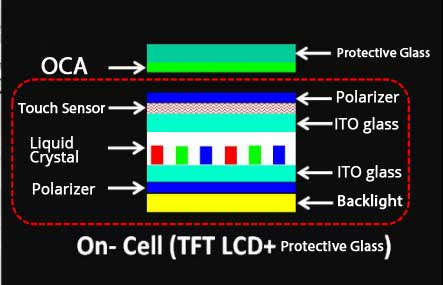
On-Cell Technology of Super AMOLED
To counter the iPhone, Samsung has also made a breakthrough in display and touch on its high-end mobile devices, targeting Apple’s IOS interface with a high-color, high-resolution touch display. It has developed its exclusive Super AMOLED On-Cell touch display and applied it to Galaxy smartphones.
AMOLED products are the achievements of red, green, and blue evaporation. The touch sensing circuit of On-Cell is integrated into the OLED packaging glass used to isolate oxygen and water vapor in the air, thus making the super AMOLED On-Cell touch display screen.
At present, Samsung outsources the production of On-Cell touch sensors to CPT’s 6th production line and Altek 5th production line, which also lays a foundation for these manufacturers to develop On-Cell displays.
Advantages and current difficulties of On-Cell TFT LCD
Display screen with integrated On-Cell touch function
Advantages:
1.The semi-finished products are standard products with strong universality.
2. Long-term order production can reduce production management costs.
3. Compared with the combination of the display screen + sensor function piece, it has a lower material cost.
Difficulties:
1. It can only be produced by display screen manufacturers, and the mainland market faces the risk of being out of stock.
2. Touch ICs need to be deeply adapted to display ICs. Touch screen manufacturers need to coordinate the program adaptation and debugging among touch IC manufacturers, display screen manufacturers, and display solution providers.
3. At present, there is no display solution provider to develop an independent physical key drive. Thus the touch key interface needs to be placed in the action area, which reduces the proportion of the screen.
4. The processing ability of the display module is needed.
5. It is challenging to control optical bonding. After changing the polarizer and optical glue material, even the cover glass, it is best to re-adapt and debug the IC drive.
6. Although the integrated display screen materials have advantages in cost, the cost of other materials is the same, with high processing costs, high direct loss costs, and high after-sales costs.
7. There is still interference in optics, such as transmittance and shadow elimination, which is still inferior to In-Cell technology.
3. OGS /TOL
OGS technology is to integrate a touch screen with protective glass. ITO conductive layer is plated on the inner side of the protective glass, and coating and photolithography are carried out directly on the protective glass. As a piece of glass and one bonding are reduced, the touch screens can be made thinner at a lower cost. However, OGS still faces the problems of strength and processing costs. Since OGS protective glass and touch screen are integrated, it usually needs to be strengthened first, then coated, etched, and finally cut. Cutting on strengthened glass is very troublesome and has a high cost and low pass rate. Moreover, some capillary cracks are formed on the edge of the glass, reducing the strength of the glass. At present, the lack of resilience has become an important factor restricting the development of OGS.
In the internal documents of some touch screen manufacturers, TOL (Touch On Lens) is used to express OGS, which means the same thing. This technology directly forms ITO conductive film and sensor on the protective glass, which can play the dual role of protective glass and touch sensor at the same time.
Compared with in-cell and on-cell, OGS has apparent cost advantages, applicability size, and technology maturity and is only slightly inferior to In-Cell in thinness. However, with the improvement of cutting and strengthening technology, the gap will continue to be narrowed; In terms of manufacturers’ layout, the threshold of the OGS process is lower, which is more conducive to the integration of traditional touchscreen manufacturers and cover plate manufacturers. Its future development space is vast.

In traditional bonding mode, the protective glass and touch sensor are optical bonded, while the LCD screen and the touch screen are air bonded.
In OGS, the touch sensor is integrated into the protective glass, and the touch screen and the LCD screen are optical bonding.
| G+G projected capacitive touchscreen | G+F projected capacitive touchscreen | OGS projected capacitive touchscreen |
| 0.7mm Cover Lens+0.4 Sensor Glass | 0.7mm Cover Lens+0.188 ITO film | 0.7mm Cover Lens |
| 1.25 mm | 1.05mm | 0.72mm |
4. Comparison of In-Cell, On-Cell, and OGS bonding technologies
| In-Cell | On-Cell | OGS | |
| Visual Effect | ★★ | ★★ | ★★★ |
| Degree of lightness | ★★★ | ★ | ★★ |
| Anti-impact and anti-fall(Strength) | ★ | ★★★ | ★★ |
| Touch sensitivity | ★★ | ★★ | ★★★ |
| Technical requirements | ★★★ | ★★ | ★ |
| Pass rate | ★ | ★★ | ★★★ |
| Process difficulty | ★★★ | ★★ | ★ |
Visual effect: OGS is the best, followed by In-Cell and On-Cell.
Lightness: In-Cell is the lightest and thinnest. This is one of the reasons why iPhone series phones can be made so thin and light. OGS is next, and On-Cell is the worst.
Anti-impact and anti-fall(Strength): On-Cell>OGS>In-Cell
Touch effect: Strictly speaking, OGS has better touch sensitivity than On-Cell/In-Cell. However, the touch effect is also related to the underlying optimization of the smartphone system. For example, the iPhone with In-Cell has a much better touch experience than many Android phones.
Cost and technical difficulty: In-Cell/On-Cell has higher difficulty and cost, followed by OGS/TOL.
Comparison of different display technologies for integrating touch technologies
| TFT LCD | TFT LCD | TFT LCD | AMOLED |
| Cover Lens | Cover Lens | Cover Lens | Cover Lens |
| Sensor | Adhesive | Adhesive | Adhesive |
| Adhesive |    |  |  |
 | Polarizer | Polarizer | Polarizer |
| Polarizer | ITO glass | ITO glass | Glass substrate |
| ITO glass | Color filter | Color filter | Color filter |
| Color filter | Liquid crystal | Sensor | Sensor |
| Liquid crystal | Sensor | Liquid crystal | OLED |
| ITO glass | ITO glass | ITO glass | Glass substrate |
| Polarizer | Polarizer | Polarizer | |
| TFT backlight | TFT backlight | TFT backlight | |
| OGS | In-Cell | On-Cell | On-Cell |
Comparison of On-Cell and In-Cell touch technology
| Product | On-Cell | In-Cell |
| Applied technology | Resistive, capacitive | Embedded optical type, embedded capacitive, and embedded resistive |
| Characteristics | Double-layer structure | Single-layer structure, no need for touch module and bonding |
| Light transmittance | 95% | about 100% |
| Advantages | Mature technology | Light and thin, simplified structure |
| Disadvantages | Heavy, requiring an external touch module | Low pass rate |
Application examples of In-Cell/On-Cell technology:
Application of In-Cell
| Display category | TFT LCD |
| Possible application | OK |
| Embedding position | On TFT-Glass |
| Difficulty of application | Most difficult |
| Technical difficulty | Under In-Cell technology, since Touch Sensor and TFT are integrated into the same glass, the distance between the finger and the Sensor is larger than that between the Sensor and TFT when touching the screen, and the interference problem is challenging to solve. Touch chip manufacturers need newly developed chips. |
| Technical advantage | The material cost is the lowest; The processing time is the shortest; The technical difficulty is very high, and the pass rate is the lowest at present. |
Application of On-Cell
| Display category | TFT LCD | OLED |
| Possible application | OK | OK |
| Embedding position | C/F-Glass | Package-Glass |
| Difficulty of application | Difficult | Easy |
| Technical difficulty | ITO sensor shares a Glass with C/F, and the pass rate is low | ITO sensor is directly engraved on the package Glass, which has low technical difficulty and a relatively high pass rate. |
| Technical advantage | Touch sensors can be integrated by display screen manufacturers, which is beneficial. | The technical difficulty is the lowest, and the thickness is the smallest. Curved screens can be made. |

